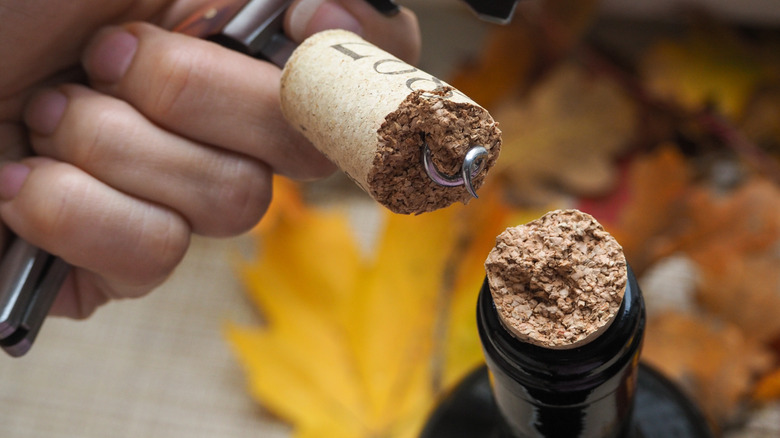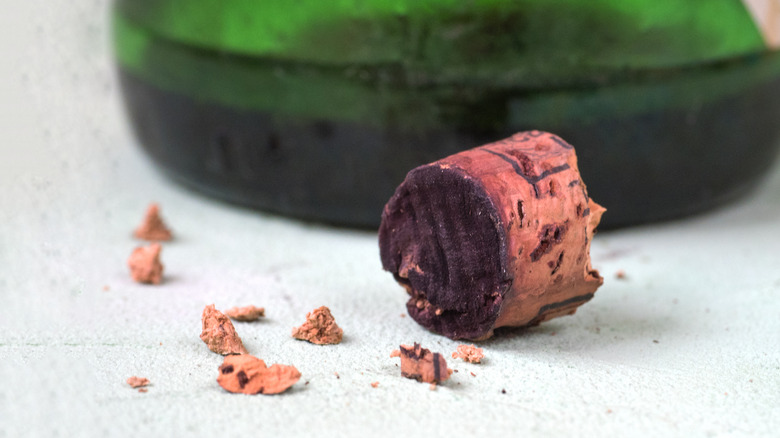What To Do When Your Wine Is Full Of Broken Cork Pieces
If you've ever attempted to open a nice bottle of wine only to have the cork break on you, you know how frustrating the experience can be. After powering through the initial tragedy of a broken wine cork, there is the headache of extracting whatever portion of the cork remains stuck in the neck of the bottle. Then you also need to assess the overall damage and do some problem-solving — how do you get the cork out? Can you still drink it, or is this bottle a lost cause?
While corks excel at keeping your wine safely contained until you're ready to drink it, they're not always excellent at holding together during their extraction. Cork breaks are more common than you might think, and keeping cork pieces out of your wine once a break occurs is almost impossible. You may find comfort in the knowledge that even sommeliers break corks. If not, the fact that removing even a fully shattered cork is still possible should help you breathe a little easier. All that stands between you and a great glass of wine once the bottle has been littered with particles is a bit of straining. Grab a filter, get your decanter, and pour to strain.
How to get a broken cork out of your wine
There are two possible scenarios you might find yourself in when navigating the removal of cork from your wine, and they require different courses of action. In the first, the cork breaks, and in your attempt to remove the remaining portion from the neck, it gets forced into the bottle as one whole, intact chunk. In this situation, your best bet at removal is a tool called a cork retriever. While not super common in the average home, these tools are used often in professional settings, and they're pretty inexpensive to procure. Essentially, you insert long prongs into the bottle, then tighten them around the cork that is inside and pull until it pops out.
If your cork crumbles during removal, breaking into small pieces you couldn't possibly grab with a cork retriever, your best bet is to simply decant the wine, pouring it through something that will catch the particles inside. If you have an aerator or sediment strainer, you're well prepared for this task, but even if not, you probably have something on hand that will do the job. A fine mesh strainer used for sifting flour or dusting powdered sugar will work great here. If that's not available, a cheesecloth, coffee filter, or even a paper towel will work, too.
Can cork contaminate your wine?
With a bunch of little cork pieces in your wine, you may be concerned it's no longer safe to drink — especially if the wine is old, and cork may have been crumbling into it for some time. While some argue that screw top wine bottles are more reliable than cork, they can't claim they're safer. Even the oldest corks are completely harmless. Made from the bark of cork oaks, natural corks are completely organic and perfectly safe. Since they're made from organic material, they can also break down or become brittle over time if not stored properly.
Decomposing corks can cause an unpleasant taste to overtake your wine, making it downright undesirable to drink. Cork taint gives a wine an underlying mildewy, wet smell that's more commonly associated with dank basements, decomposing cardboard, or a dog after a rainy walk. It's caused by a contaminant called 2,4,6-trichloroanisole (or just TCA for short), which usually occurs when a cork is made from tree bark that was exposed to fungicides or insecticides. These chemicals interact with naturally occurring fungi, bacteria, or mold within the cork, and they produce TCA as a defense mechanism. While offensive to the olfactories, TCA is not dangerous to consume — but if you suspect your wine has cork taint, you may want to dump it and get a new bottle. Hair of the dog is for the day after drinking, not tasting notes you want in your wine.



